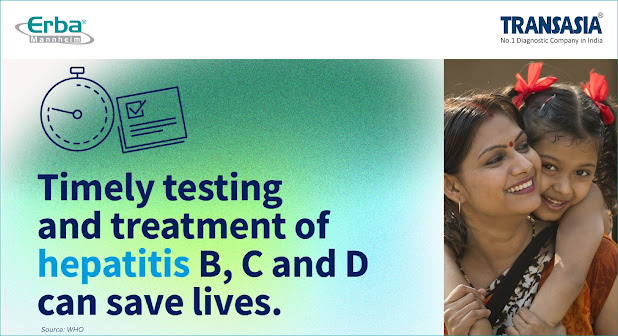Bringing viral hepatitis out of the shadows!
Hepatitis, as we all know is an inflammation of the liver and can be
caused due to alcohol abuse, medications, and certain medical conditions.
However, hepatitis is often caused by a virus and is a matter of concern as it
can lead to severe disease and liver cancer.
Elimination of viral
hepatitis – a global concern
Did you know that viral hepatitis is
three times more deadly than HIV and nine times more than malaria? It’s no
wonder then that WHO is focusing its efforts to diagnosis, treat and prevent
chronic viral hepatitis by bringing hepatitis care closer to the primary health
facilities so that people get better access to early diagnosis and treatment.
WHO aims to achieve hepatitis
elimination by 2030. To get there, WHO calls on countries to achieve specific
interim targets by 2025:
·
To reduce new infections of hepatitis B and C by 50 %, and
·
To reduce deaths from liver cancer by 40 %
·
To ensure that 60% of people with hepatitis B and C virus are
diagnosed
·
And 50% of those eligible receive appropriate treatment
In India, hepatitis C in particular
is an emerging infection and an important pathogen causing liver disease. The
high risk of chronicity of this blood-borne infection and its association with
hepatocellular carcinoma underscores its public health importance.
Hepatitis C and
blood transfusion
Blood transfusion is an easy mode for
transmission of hepatitis C infection as it allows transmission of a large
quantum of infective virions to the susceptible patient. In developed
countries, the rapid improvement of healthcare conditions and the introduction
of HCV screening for blood donors have led to a sharp decrease in the incidence
of hepatitis C, but the epidemic continues to spread in developing countries,
where the virus is still transmitted through unscreened blood transfusions.
Virological tools for diagnosis
Virological diagnosis of HCV
infection is based on two categories of laboratory tests, namely
· Indirect assays: Serologic assays detecting specific antibody to HCV (anti-HCV) (indirect tests)
·
Combined assays: Serologic assays detecting specific
antibody to HCV (anti-HCV) and core antigen to hepatitis C
·
Direct assays: Assays that can detect, quantify,
or characterize the components of HCV viral particles, such as HCV RNA and core
antigen.
Generations in serological
assays (ELISA):
The different generations of
immunoassays for anti-HCV:
|
Generation |
Significance |
|
1st
Generation |
Detection
of antibodies to NS4 antigen only |
|
2nd
Generation |
Detection
of antibodies to NS3, NS4 and core antigen |
|
3rd
generation |
Detection
of antibodies to NS3, NS4, NS5 and core antigen |
The window period has been documented to decrease from approximately 16 weeks
to 10 weeks and finally to 8 weeks with the introduction of first-, second-,
and third-generation anti-HCV ELISAs, respectively.
The 4th generation
assays
The latest, fourth generation of
tests simultaneously detect HCV capsid antigen as well as antibodies to the
core, NS3, NS4, and NS5 regions of the virus. These assays are also known as
combination assays and offer a higher sensitivity and specificity.
In fact, owing to its reliability, the
technical committee of NACO has reviewed specification for kits to be used in
blood banks and encouraged the procurement of fourth generation assays.
|
Features |
HCV
4th Generation ELISA |
HCV
3rd generation ELISA |
|
Detects HCV Antigen |
✓ |
✕ |
|
Detects Anti-HCV IgG Antibody |
✓ |
✓ |
|
Detects Anti-HCV IgM Antibody |
✓ |
✕ |
|
Window period |
< 28 days |
> 66 days |
|
Accuracy |
Highly accurate due to antigen detection |
Accurate |
A window period is the time between
the first infection and when the test can reliably detect the infection. Any
third generation kit usually offers a window period in the reported range of 15
- 180 days. The simultaneous detection
of antigen and antibodies with ErbaLisa HCV Gen4 Ag+Ab will greatly aid in
screening HCV more accurately, as the window period for HCV detection will be
reduced to less than 28 days.
Most of the analytical studies and
research publications also suggest that the HCV core Ag assay is a potentially
useful assay for screening blood donors. It greatly helps to minimize the risk
of using HCV positive blood from a patient in the window period of HCV
infection. The HCV core Ag assay may well be an alternative to the molecular
techniques.
References:
·
https://pubmed.ncbi.nlm.nih.gov/16901579/
·
https://www.peertechzpublications.com/articles/AHR-6-126.php
·
https://wbhealth.gov.in/NVHCP/contents/page/background
·
https://www.ias.ac.in/article/fulltext/jbsc/033/04/0465-0473
Authored by:
Ajinkya Upasani
Asst. Product Manager – Immunology (Reagents)
Transasia Bio-Medicals Ltd.





Comments
Post a Comment